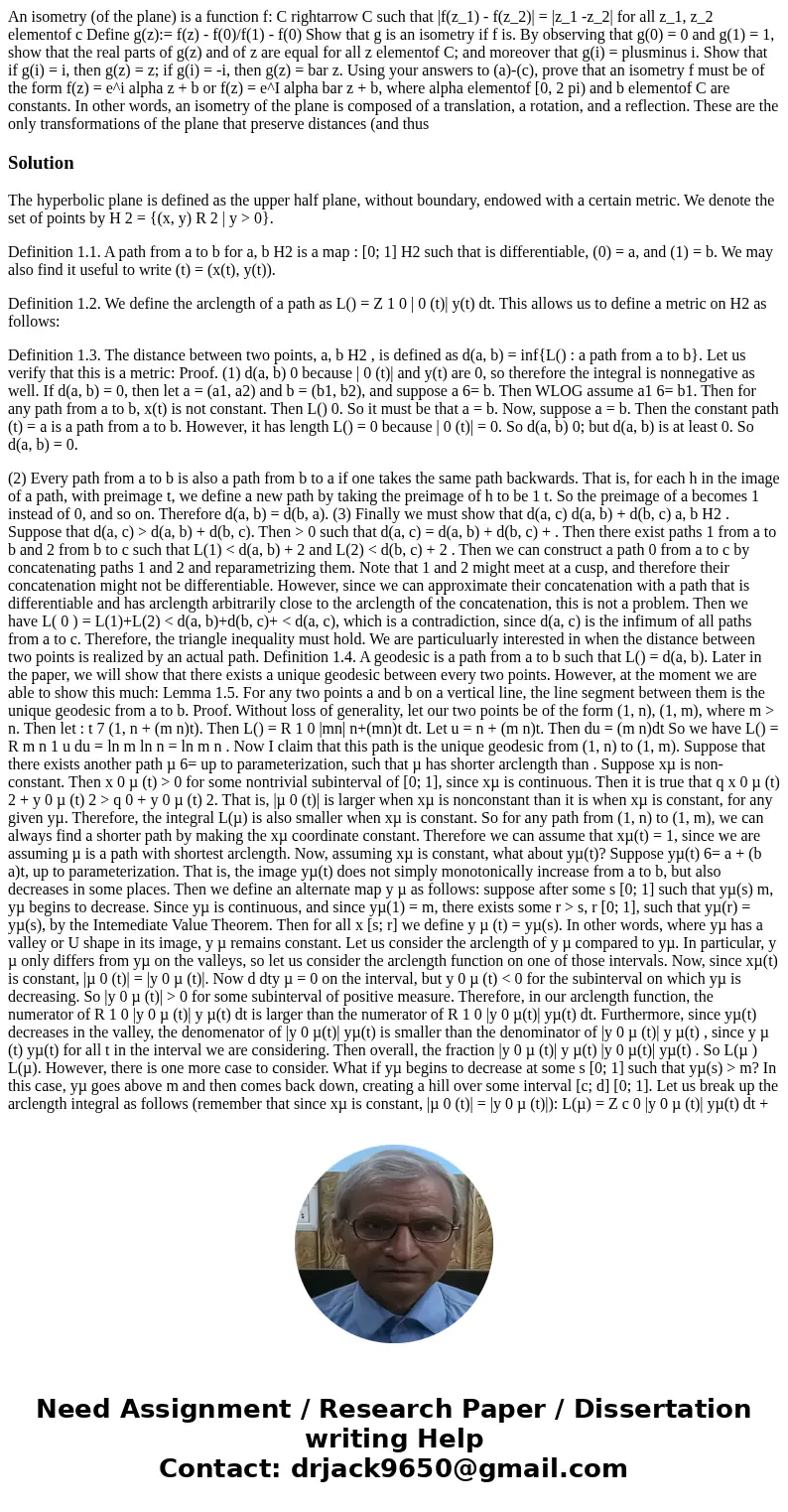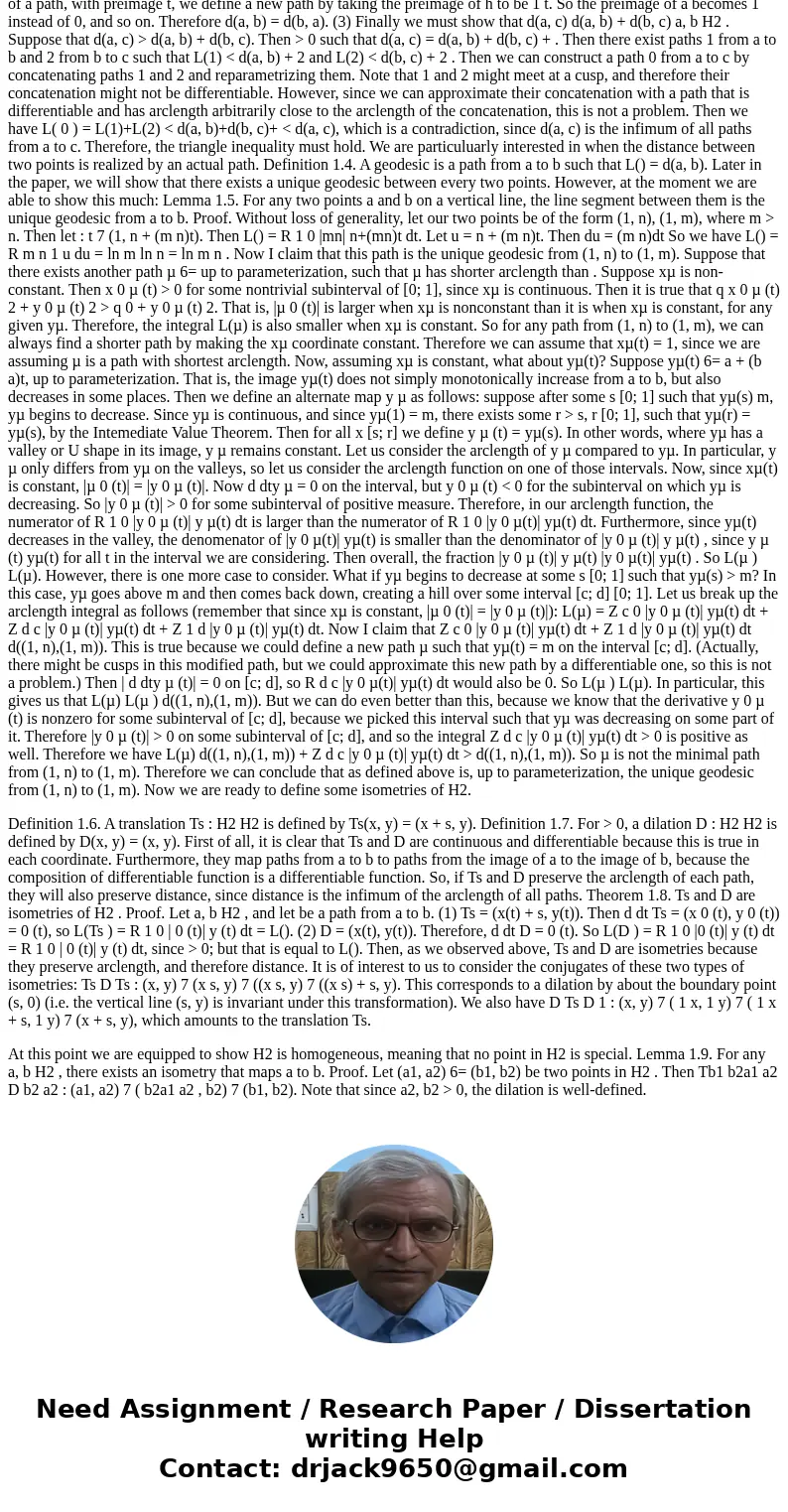An isometry of the plane is a function f C rightarrow C such
Solution
The hyperbolic plane is defined as the upper half plane, without boundary, endowed with a certain metric. We denote the set of points by H 2 = {(x, y) R 2 | y > 0}.
Definition 1.1. A path from a to b for a, b H2 is a map : [0; 1] H2 such that is differentiable, (0) = a, and (1) = b. We may also find it useful to write (t) = (x(t), y(t)).
Definition 1.2. We define the arclength of a path as L() = Z 1 0 | 0 (t)| y(t) dt. This allows us to define a metric on H2 as follows:
Definition 1.3. The distance between two points, a, b H2 , is defined as d(a, b) = inf{L() : a path from a to b}. Let us verify that this is a metric: Proof. (1) d(a, b) 0 because | 0 (t)| and y(t) are 0, so therefore the integral is nonnegative as well. If d(a, b) = 0, then let a = (a1, a2) and b = (b1, b2), and suppose a 6= b. Then WLOG assume a1 6= b1. Then for any path from a to b, x(t) is not constant. Then L() 0. So it must be that a = b. Now, suppose a = b. Then the constant path (t) = a is a path from a to b. However, it has length L() = 0 because | 0 (t)| = 0. So d(a, b) 0; but d(a, b) is at least 0. So d(a, b) = 0.
(2) Every path from a to b is also a path from b to a if one takes the same path backwards. That is, for each h in the image of a path, with preimage t, we define a new path by taking the preimage of h to be 1 t. So the preimage of a becomes 1 instead of 0, and so on. Therefore d(a, b) = d(b, a). (3) Finally we must show that d(a, c) d(a, b) + d(b, c) a, b H2 . Suppose that d(a, c) > d(a, b) + d(b, c). Then > 0 such that d(a, c) = d(a, b) + d(b, c) + . Then there exist paths 1 from a to b and 2 from b to c such that L(1) < d(a, b) + 2 and L(2) < d(b, c) + 2 . Then we can construct a path 0 from a to c by concatenating paths 1 and 2 and reparametrizing them. Note that 1 and 2 might meet at a cusp, and therefore their concatenation might not be differentiable. However, since we can approximate their concatenation with a path that is differentiable and has arclength arbitrarily close to the arclength of the concatenation, this is not a problem. Then we have L( 0 ) = L(1)+L(2) < d(a, b)+d(b, c)+ < d(a, c), which is a contradiction, since d(a, c) is the infimum of all paths from a to c. Therefore, the triangle inequality must hold. We are particuluarly interested in when the distance between two points is realized by an actual path. Definition 1.4. A geodesic is a path from a to b such that L() = d(a, b). Later in the paper, we will show that there exists a unique geodesic between every two points. However, at the moment we are able to show this much: Lemma 1.5. For any two points a and b on a vertical line, the line segment between them is the unique geodesic from a to b. Proof. Without loss of generality, let our two points be of the form (1, n), (1, m), where m > n. Then let : t 7 (1, n + (m n)t). Then L() = R 1 0 |mn| n+(mn)t dt. Let u = n + (m n)t. Then du = (m n)dt So we have L() = R m n 1 u du = ln m ln n = ln m n . Now I claim that this path is the unique geodesic from (1, n) to (1, m). Suppose that there exists another path µ 6= up to parameterization, such that µ has shorter arclength than . Suppose xµ is non-constant. Then x 0 µ (t) > 0 for some nontrivial subinterval of [0; 1], since xµ is continuous. Then it is true that q x 0 µ (t) 2 + y 0 µ (t) 2 > q 0 + y 0 µ (t) 2. That is, |µ 0 (t)| is larger when xµ is nonconstant than it is when xµ is constant, for any given yµ. Therefore, the integral L(µ) is also smaller when xµ is constant. So for any path from (1, n) to (1, m), we can always find a shorter path by making the xµ coordinate constant. Therefore we can assume that xµ(t) = 1, since we are assuming µ is a path with shortest arclength. Now, assuming xµ is constant, what about yµ(t)? Suppose yµ(t) 6= a + (b a)t, up to parameterization. That is, the image yµ(t) does not simply monotonically increase from a to b, but also decreases in some places. Then we define an alternate map y µ as follows: suppose after some s [0; 1] such that yµ(s) m, yµ begins to decrease. Since yµ is continuous, and since yµ(1) = m, there exists some r > s, r [0; 1], such that yµ(r) = yµ(s), by the Intemediate Value Theorem. Then for all x [s; r] we define y µ (t) = yµ(s). In other words, where yµ has a valley or U shape in its image, y µ remains constant. Let us consider the arclength of y µ compared to yµ. In particular, y µ only differs from yµ on the valleys, so let us consider the arclength function on one of those intervals. Now, since xµ(t) is constant, |µ 0 (t)| = |y 0 µ (t)|. Now d dty µ = 0 on the interval, but y 0 µ (t) < 0 for the subinterval on which yµ is decreasing. So |y 0 µ (t)| > 0 for some subinterval of positive measure. Therefore, in our arclength function, the numerator of R 1 0 |y 0 µ (t)| y µ(t) dt is larger than the numerator of R 1 0 |y 0 µ(t)| yµ(t) dt. Furthermore, since yµ(t) decreases in the valley, the denomenator of |y 0 µ(t)| yµ(t) is smaller than the denominator of |y 0 µ (t)| y µ(t) , since y µ (t) yµ(t) for all t in the interval we are considering. Then overall, the fraction |y 0 µ (t)| y µ(t) |y 0 µ(t)| yµ(t) . So L(µ ) L(µ). However, there is one more case to consider. What if yµ begins to decrease at some s [0; 1] such that yµ(s) > m? In this case, yµ goes above m and then comes back down, creating a hill over some interval [c; d] [0; 1]. Let us break up the arclength integral as follows (remember that since xµ is constant, |µ 0 (t)| = |y 0 µ (t)|): L(µ) = Z c 0 |y 0 µ (t)| yµ(t) dt + Z d c |y 0 µ (t)| yµ(t) dt + Z 1 d |y 0 µ (t)| yµ(t) dt. Now I claim that Z c 0 |y 0 µ (t)| yµ(t) dt + Z 1 d |y 0 µ (t)| yµ(t) dt d((1, n),(1, m)). This is true because we could define a new path µ such that yµ(t) = m on the interval [c; d]. (Actually, there might be cusps in this modified path, but we could approximate this new path by a differentiable one, so this is not a problem.) Then | d dty µ (t)| = 0 on [c; d], so R d c |y 0 µ(t)| yµ(t) dt would also be 0. So L(µ ) L(µ). In particular, this gives us that L(µ) L(µ ) d((1, n),(1, m)). But we can do even better than this, because we know that the derivative y 0 µ (t) is nonzero for some subinterval of [c; d], because we picked this interval such that yµ was decreasing on some part of it. Therefore |y 0 µ (t)| > 0 on some subinterval of [c; d], and so the integral Z d c |y 0 µ (t)| yµ(t) dt > 0 is positive as well. Therefore we have L(µ) d((1, n),(1, m)) + Z d c |y 0 µ (t)| yµ(t) dt > d((1, n),(1, m)). So µ is not the minimal path from (1, n) to (1, m). Therefore we can conclude that as defined above is, up to parameterization, the unique geodesic from (1, n) to (1, m). Now we are ready to define some isometries of H2.
Definition 1.6. A translation Ts : H2 H2 is defined by Ts(x, y) = (x + s, y). Definition 1.7. For > 0, a dilation D : H2 H2 is defined by D(x, y) = (x, y). First of all, it is clear that Ts and D are continuous and differentiable because this is true in each coordinate. Furthermore, they map paths from a to b to paths from the image of a to the image of b, because the composition of differentiable function is a differentiable function. So, if Ts and D preserve the arclength of each path, they will also preserve distance, since distance is the infimum of the arclength of all paths. Theorem 1.8. Ts and D are isometries of H2 . Proof. Let a, b H2 , and let be a path from a to b. (1) Ts = (x(t) + s, y(t)). Then d dt Ts = (x 0 (t), y 0 (t)) = 0 (t), so L(Ts ) = R 1 0 | 0 (t)| y (t) dt = L(). (2) D = (x(t), y(t)). Therefore, d dt D = 0 (t). So L(D ) = R 1 0 |0 (t)| y (t) dt = R 1 0 | 0 (t)| y (t) dt, since > 0; but that is equal to L(). Then, as we observed above, Ts and D are isometries because they preserve arclength, and therefore distance. It is of interest to us to consider the conjugates of these two types of isometries: Ts D Ts : (x, y) 7 (x s, y) 7 ((x s, y) 7 ((x s) + s, y). This corresponds to a dilation by about the boundary point (s, 0) (i.e. the vertical line (s, y) is invariant under this transformation). We also have D Ts D 1 : (x, y) 7 ( 1 x, 1 y) 7 ( 1 x + s, 1 y) 7 (x + s, y), which amounts to the translation Ts.
At this point we are equipped to show H2 is homogeneous, meaning that no point in H2 is special. Lemma 1.9. For any a, b H2 , there exists an isometry that maps a to b. Proof. Let (a1, a2) 6= (b1, b2) be two points in H2 . Then Tb1 b2a1 a2 D b2 a2 : (a1, a2) 7 ( b2a1 a2 , b2) 7 (b1, b2). Note that since a2, b2 > 0, the dilation is well-defined.


 Homework Sourse
Homework Sourse